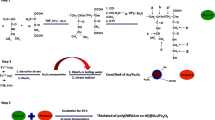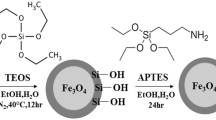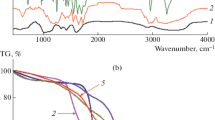Abstract
Hydrogel formed by fluoroalkyl double-ended polyethylene glycol (Rf-PEG) micelles was studied to assess its properties to encapsulate a hydrophobic electron spin labeled drug, Chlorambucil–Tempol adduct (CT), and to control and sustain the drug release. The drug loaded hydrogel samples were characterized with variable-temperature dependent EPR experiment, and EPR theoretical lineshape analysis. It was found that CT molecules reside in the hydrophobic Rf-cores/IPDU shells of the Rf-PEG micelles and the maximum molecular-level loading capacity was estimated to be 18.8 mg per gram of the Rf-PEG. It has been known that Rf-PEG hydrogel with certain molecular masses for the fluoroalkyl group and the PEG chain shows properties of sol/gel phase coexistence and surface erosion, which represent the favorable condition for a pharmaceutical depot to control the kinetics of drug release. To evaluate the Rf-PEG’s biocompatibility and kinetics of the drug release, a cell proliferation assay was carried out on human oropharyngeal carcinoma (KB) cells. The results show that Rf-PEG is biocompatible and able to release CT to the cell media with a constant equilibrium concentration independent of the amount of CT loaded hydrogel.









Similar content being viewed by others
References
Harris JM (1992) Poly(ethylene glycol) chemistry biotechnical and biomedical application. Plenum Press, New York
Wang F, Bronich TK, Kabanov AV, Rauh RD, Roovers J (2005) Bioconjug Chem 16:397–405
Zeng F, Liu J, Allen C (2004) Biomacromolecules 5:1810–1817
Lavasanifar A, Samuel J, Kwon GS (2002) Adv Drug Deliv Rev 54:169–190
La SB, Okano T, Kataoka K (1996) J Pharm Sci 85:85–90
Soo PL, Luo L, Maysinger D, Eisenberg A (2002) Langmuir 18:9996–10004
Kwon GS, Kataoka K (1995) Adv Drug Deliv Rev 16:295–309
Hamley IW (2000) Introduction to soft matter. John Wiley & Sons, Chichester
Torchilin VP (2001) J Control Release 73:137–172
Tae G, Kornfield JA, Hubbell JA, Johannsmann D, Hogen-Esch TE (2001) Macromolecules 34:6409–6419
Xu B, Li L, Yekta A, Masoumi Z, Kanagalingam S, Winnik MA, Zhang K, Macdonald PM (1997) Langmuir 13:2447–2456
Uhrich KE, Cannizzaro SM, Langer RS, Shakesheff KM (1999) Chem Rev 99:3181–3198
Ambade AV, Savariar EN, Thayumanavan S (2005) Mol Pharm Reviews:A-I
El-Nokaly MA, Piatt DM, Charpentier BA (1993) Polymeric delivery systems: properties and applications. American Chemical Society, Washington, DC
Yokoyama M, Kwon GS, Okano T, Sakurai Y, Ekimoto H, Shibazaki C, Kataoka K (1991) Cancer Res 51:3229–3236
Yokoyama M, Okano T, Sakurai Y, Naito M, Kataoka K (1994) J Control Release 28:59–65
Shuai X, Merdan T, Schaper AK, Xi F, Kissel T (2004) Bioconjug Chem 15:441–448
Ge H, Hu, Y, Jiang X, Cheng D, Yuan Y, Bi H, Yang C (2002) J Pharm Sci 91:1463–1473
Brigger I, Chaminade P, Marsaud V, Appel M, Besnard M, Gurny R, Renoir M, Couvreur P (2001) Int J Pharm 214:37–42
Jette KK, Law D, Schmitt EA, Kwon GS (2004) Pharm Res 21:1184–1191
Opanasopit P, Ngawhirunpat T, Chaidedgumjorn A, Rojanarata T, Apirakaramwong A, Phongying S, Choochottiros C, Chirachanchai S (2006) Eur J Pharm Biopharm 64:269–276
Francis MF, Lavoie L, Winnik FM, Leroux J-C (2003) Eur J Pharm Biopharm 56:337–346
Martini G, Morandi S, Rossi S, Ristori S (2004) Prog Colloid Polym Sci 126:146–150
Martini G, Balzi M, Becciolini A, Ristori S, Rossi S (2004) J Fluor Chem 125:253–259
Prabhutendolkar A, Mathias E, Liu L, Ba Y, Kornfield JA (2005) 229th ACS National Meeting. Poster, Polymer and Sci-Mix Sections, San Diego
Prabhutendolkar A, Liu X, Mathias E, Ba Y, Kornfield JA (2006) Drug Deliv 13:433–440
Farmer PB (1987) Pharmacol Ther 35:301–358
Mclean A, Newell D, Baker G, Connors T (1980) Biochem Pharmacol 29:2039–2047
Deluca PP, Mehta RC, Hausherger AG, Thanoo BC (1993) Polymeric delivery systems. Washington, DC
Bader H, Ringsdorf H, Schmidt B (1984) Angew Makromol Chem 123/124:457–485
Kopecek J (1977) Polym Med 7:191–221
Pietschmann C (2001) Livingbridges 54–57
Panasci L, Paiement JP, Christodoulopoulos G, Belenkov A, Malapetsa A, Aloyz R (2001) Clin Cancer Res 7:454–461
Monti E, Supino R, Colleoni M, Costa B, Ravizza R, Gariboldi M (2001) J Cell Biochem 82:271–276
Ravizza R, Cereda E, Monti E, Gariboldi M (2004) Int J Oncol 25:1817–1822
Bell JE (1981) Spectroscopy in biochemistry, vol II. CRC Press, Inc, Boca Raton
Kivelson D (1960) J Chem Phys 33:1094–1106
Goldman SA, Bruno GV, Freed JH (1972) J Phys Chem 76:1858–1860
Hudson A, Luckhurst GR (1969) Chem Rev 69:191–225
Woliñka-Grabczyk A, Bednarski W, Jankowski A, Waplak S (2005) Polymer 46:2461–2471
Scheuermann R, Roduner E, Batchelor SN (2001) J Phys Chem B 105:11474–11479
Tae G, Kornfield JA, Hubbell JA, Lal J (2002) Macromolecules 35:4448–4457
Acknowledgment
This project is supported by the NSF Grant 0351848. Thanks to DOD for funding the EPR spectrometer under the grant d20030904hsi.
Author information
Authors and Affiliations
Corresponding author
Rights and permissions
About this article
Cite this article
Liu, X., Mao, Y., Mathias, E.V. et al. Study the property of double-ended fluoroalkyl poly(ethylene glycol) hydrogel as a depot for hydrophobic drug delivery using electron paramagnetic resonance technique and cell proliferation assay. J Sol-Gel Sci Technol 45, 269–278 (2008). https://doi.org/10.1007/s10971-007-1659-y
Received:
Accepted:
Published:
Issue Date:
DOI: https://doi.org/10.1007/s10971-007-1659-y




